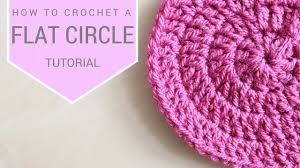How to Crochet a Flat Circle
https://www.mybluprint.com/article/learn-to-crochet-flat-circles-its-all-about-the-increase
by Kathryn Senior
by Kathryn Senior
Here's another explanation By Sher of Philly Surburbs, PA.
http://flythecoopcrafts.blogspot.com/2015/03/crochet-basics-flat-circle.html

How to Crochet a Flat Circle
If the metrics are off, instead of a disk that lies perfectly flat, your circle is apt to become a ruffle, cup, or potato chip.
Important! No matter the kind of project, Count Your Stitches!! Do IT Frequently!!
Get it right from the very start:
Every crochet project begins with a foundation, often a chain of some length. Some patterns will start your circle with a short chain. The easiest way to start a circle is with a Magic Ring (Magic Circle) or Adjustable Loop.
Important!
Number of stitches for first round:
- Single crochet (sc): Start with 6-8 stitches in Round 1
- Half double crochet (hdc): Start with 8-10 stitches in Round 1
- Double crochet (dc): Start with 10-13 stitches in Round 1
To make your circle grow just enough without getting too big around the edge, you need to know the rules of how many times to increase and where to increase each round. Luckily, these rules are the same whether you are making a crochet circle using sc, hdc or dc stitches. Only one set of rules to rule them all!
Note that you must start with the recommended number of stitches that we laid out in our first tip if you want this formula to work its magic.
Increase Pattern for ALL Circles
- Round 1: Start with the recommended number of stitches as listed above in a Magic Ring.
- Round 2: Make 2 stitches into each stitch of Round 1. (You're increasing in every stitch.')
- Round 3: Work 2 stitches into the first stitch of the previous round, then 1 stitch into the next stitch. Repeat this pattern of 2 then 1 all around. (You're increacing every other stitch.)
- Round 4: Make 2 stitches into the first stitch of the previous round, then 1 stitch into each of the next 2 stitches. Repeat this pattern around (you're increasing every third stitch). Also notice that in round 4 there are 4 stitches in every repeat sequence.
- Round 5: Make 2 stitches into the first stitch, then 1 stitch into each of the next 3 stitches. Repeat this pattern around (you're increasing every fourth stitch). For round 5 there will be 5 stitches in every repeat sequence, (the increase plus three regular stitches).
The Symmetry
So, when Round 10 completed, if you started with 8 stitches (of course you're doing sc or hdc for that number), the total number of stitches in the round is 80. This makes it so easy to keep track of your work, and to detect mistakes. In this same 8-stitch circle, Round 5 will have a total of 40 stitches when complete.
Round 1: 12 dc (12)
Round 2: 12 dc + 12 dc (24)
Round 3: 24 dc + 12 dc (36)
Round 4: 36 dc + 12 dc (48)
Round 5: 48 dc + 12 dc (60)
Instead of joining each round with a slip stitch to make a ring, the join is eliminated to make the work a continuous spiral. Round endings need to be marked with a scrap of yarn or other marker so the increases can be placed correctly.
Avoid the Polygon
The instructions above with the increase placed at the beginning of each set are a recipe for a polygon with the same number of sides and the number of stitches used to start the circle. To avoid the polygon and make a truly round circle, do this: Begin even numbered rounds not with the first increase, but with half the number of single stitches for that round, then work the remaining half at the very end of the round. This scheme will offset the increases so that they will not fall in the exact same place as in the previous round. Here's an example for an 8-stitch sc circle: In this scheme the increases come after the single stitches in each set, rather than at the beginning.